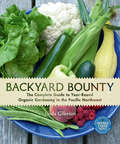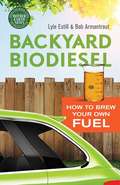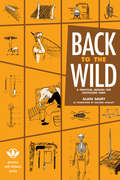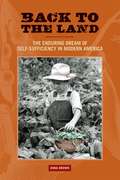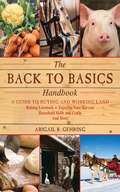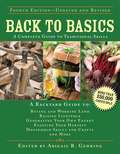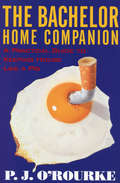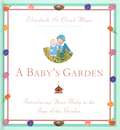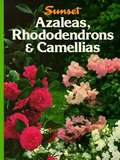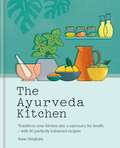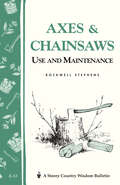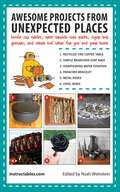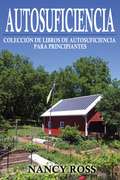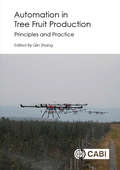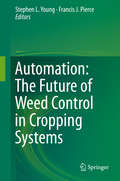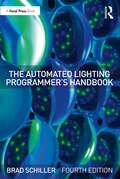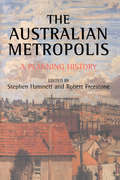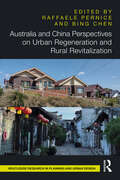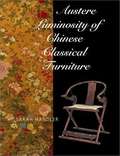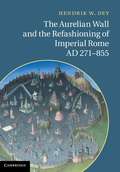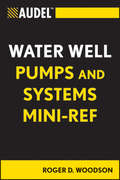- Table View
- List View
Backyard Bounty
by Linda GilkesonThis practical guide is packed with simple, low-maintenance methods to produce the most organically grown food all year round from any home garden. With advice on soil preparation, composting, seeding, watering, mulching, pruning, winter crop planting schedules, greenhouses and more, as well as a wealth of information specific to the West Coast climate, Backyard Bounty will get you growing.
Backyard Biodiesel
by Lyle Estill Bob ArmantroutSmall-scale home biodiesel production holds a singular attraction for the do-it-yourself enthusiast. While perhaps it can't save the world, this unique renewable fuel is economical, fun to make, better for the environment, and will help you reduce your dependence on Big Oil. And getting started is easier than you think.Backyard Biodiesel is written by two recognized experts in the field of small-scale biofuels. This comprehensive hands-on, practical, DIY guide includes: The basics of small-scale brewing--recipes, strategies, and technologies Advanced backyard analytics and troubleshooting Safety considerations and regulatory issues Topping up the tank--how to put your biodiesel to work for youMaking your own fuel is not only possible, it is rewarding. Designed to be accessible to everyone from readers with no prior technical expertise to alternative energy buffs, Backyard Biodiesel is a must-read for any aspiring brewer, packed with everything you need to get up and running quickly and safely.Lyle Estill is the president and co-founder of Piedmont Biofuels and the author of Industrial Evolution, Small is Possible, and Small Stories, Big Changes. He has won numerous awards for his commitment to sustainability, outreach, community development, and leadership.Bob Armantrout helped to manage four commercial biodiesel plants before joining Piedmont Biofuels in 2007. He works as an instructor at Central Carolina Community College, where he spearheads an innovative two-year biofuels degree program.
Back to the Wild
by Alain SauryThis practical and poetic "survival manual" is the first English translation of the French masterpiece of living wild in the world and creating a permaculture. Back to the Wild is your source for everything from cartography to hunting and dressing wild game to cooking without a kitchen.Its author, the late Alain Saury, was a respected author, poet, actor, activist, and artist who created the first vegetarian organization in France. His concerns about human survival in dangerous times inspired him to create this remarkable guidebook.Beautifully designed and organized, the material in this book illustrates the importance in having an intimate relationship with nature, and it leads the reader back to wild, whether the journey is taken by choice or by necessity.
Back To The Land
by Dona BrownFor many, "going back to the land" brings to mind the 1960s and 1970s--hippie communes and the Summer of Love,The Whole Earth CatalogandMother Earth News. More recently, the movement has reemerged in a new enthusiasm for locally produced food and more sustainable energy paths. But these latest back-to-the-landers are part of a much larger story. Americans have been dreaming of returning to the land ever since they started to leave it. InBack to the Land, Dona Brown explores the history of this recurring impulse. Back-to-the-landers have often been viewed as nostalgic escapists or romantic nature-lovers. But their own words reveal a more complex story. In such projects as Gustav Stickley's Craftsman Farms, Frank Lloyd Wright's "Broadacre City," and Helen and Scott Nearing's quest for "the good life," Brown finds that the return to the farm has meant less a going-backwards than a going-forwards, a way to meet the challenges of the modern era. Progressive reformers pushed for homesteading to help impoverished workers get out of unhealthy urban slums. Depression-era back-to-the-landers, wary of the centralizing power of the New Deal, embraced a new "third way" politics of decentralism and regionalism. Later still, the movement merged with environmentalism. To understand Americans' response to these back-to-the-land ideas, Brown turns to the fan letters of ordinary readers--retired teachers and overworked clerks, recent immigrants and single women. In seeking their rural roots, Brown argues, Americans have striven above all for the independence and self-sufficiency they associate with the agrarian ideal.
The Back to Basics Handbook: A Guide to Buying and Working Land, Raising Livestock, Enjoying Your Harvest, Household Skills and Crafts, and More (Handbook Series)
by Abigail R. GehringAnyone who wants to learn basic living skills-the kind employed by our forefathers-and adapt them for a better life in the twenty-first century need look no further than this eminently useful, full-color guide. With hundreds of projects, step-by-step sequences, photographs, charts, and illustrations, The Back to Basics Handbook will help you dye your own wool with plant pigments, graft trees, raise chickens, craft a hutch table with hand tools, and make treats such as blueberry peach jam and cheddar cheese. The truly ambitious will find instructions on how to build a log cabin or an adobe brick homestead. More than just practical advice, this is also a book for dreamers- even if you live in a city apartment you will find your imagination sparked, and there's no reason why you can't, for example, make a loom and weave a rag rug. Complete with tips for old-fashioned fun (square dancing calls, homemade toys, and kayaking tips), this is the ultimate concise guide to voluntary simplicity.
Back to Basics: A Complete Guide to Traditional Skills (Back to Basics Guides)
by Abigail R. GehringAnyone who wants to learn basic living skills--the kind employed by our forefathers--and adapt them for a better life in the twenty-first century need look no further than this eminently useful, full-color guide. Countless readers have turned to Back to Basics for inspiration and instruction, escaping to an era before power saws and fast food restaurants and rediscovering the pleasures and challenges of a healthier, greener, and more self-sufficient lifestyle. Now newly updated, the hundreds of projects, step-by-step sequences, photographs, charts, and illustrations in Back to Basics will help you dye your own wool with plant pigments, graft trees, raise chickens, craft a hutch table with hand tools, and make treats such as blueberry peach jam and cheddar cheese. The truly ambitious will find instructions on how to build a log cabin or an adobe brick homestead. More than just practical advice, this is also a book for dreamers--even if you live in a city apartment you will find your imagination sparked, and there's no reason why you can't, for example, make a loom and weave a rag rug. Complete with tips for old-fashioned fun (square dancing calls, homemade toys, and kayaking tips), this may be the most thorough book on voluntary simplicity available.
Back to Basics: A Complete Guide to Traditional Skills (Back to Basics Guides)
by Abigail R. GehringAnyone who wants to learn basic living skills—the kind employed by our forefathers—and adapt them for a better life in the twenty-first century need look no further than this eminently useful, full-color guide. Countless readers have turned to Back to Basics for inspiration and instruction, escaping to an era before power saws and fast food restaurants and rediscovering the pleasures and challenges of a healthier, greener, and more self-sufficient lifestyle. Now newly updated, the hundreds of projects, step-by-step sequences, photographs, charts, and illustrations in Back to Basics will help you dye your own wool with plant pigments, graft trees, raise chickens, craft a hutch table with hand tools, and make treats such as blueberry peach jam and cheddar cheese. The truly ambitious will find instructions on how to build a log cabin or an adobe brick homestead. More than just practical advice, this is also a book for dreamers—even if you live in a city apartment you will find your imagination sparked, and there's no reason why you can't, for example, make a loom and weave a rag rug. Complete with tips for old-fashioned fun (square dancing calls, homemade toys, and kayaking tips), this may be the most thorough book on voluntary simplicity available.
The Bachelor Home Companion: A Practical Guide to Keeping House Like a Pig
by P. J. O'Rourke"I always wanted to be a bachelor when I grew up. My friends may have had fantasies about raking the yard, seeing their loved ones in pin curlers and cleaning the garage on Sundays, but not me. I saw myself at thirty-eight lounging around a penthouse in a brocade smoking jacket. Vivaldi would be playing on the stereo. I'd sip brandy from a snifter the size of a fish tank and leaf through an address book full of R-rated phone numbers. ..." Always with tongue firmly in cheek, the author points out the trouble, for bachelors, with laundromats, cooking, shopping and everything else that goes along with managing a house. "Bachelor cooking is a matter of attitude. If you think of it as setting fire to things and making a mess, it's fun. It's not so much fun if you think of it as dinner. Fortunately, baloney, cheeseburgers, beer, and potato-chip dip provide all the daily nutrients bachelors are known to require. I mean, I hope they do."
The Bachelor Home Companion: A Practical Guide to Keeping House Like a Pig
by P. J. O'Rourke<p>From P. J. O'Rourke, bestselling author and expert bachelor, comes a hilarious look at domestic life. Or, as P. J. puts it, "This is a book about cooking, cleaning, and housekeeping for people who don't know how to do any of those things and aren't about to learn." <p>In addition to debunking popular myths about bachelors (they are in fact not creatures known to hang around the house in silk smoking jackets, sipping brandy from oversized snifters) P. J. offers some useful sections on cleaning—or how best to avoid doing it: "Spill something fresh on the floor because a slippery floor is much more like a clean, waxed floor than a stinky floor is."; "Every month or so, take the curtains down-and throw them away. Turn the lights off if you don't want the neighbors to see what you're doing. The same goes for slipcovers."; "Don't use Drano if a toilet gets clogged. <p>Remembering, the toilet is a dog's idea of Perrier. And you don't want a dog with a melted tongue."; "Sheets can be kept clean by getting drunk and falling asleep with your clothes on." In the inimitable style that has made him one of America's most popular humorists, P. J. provides an essential guide to the practical business of living in the modern world and proves that.</p>
A Baby’s Garden: Introducing Your Baby to the Joys of the Garden
by Eva Saull Elizabeth St. Cloud MuseWith the help of this whimsically illustrated and lovingly written keepsake journal, you can create and record precious moments spent with your baby in the garden. The earliest perceptions of childhood make the most indelible impressions. Whether it is listening to birds singing, smelling the grass or the flowers, or throwing leaves in the air to watch them fall, here are ideas for everyday adventures. Through joint explorations of nature, you can stimulate your child's senses and together experience the sights, sounds, textures, and scents of your own backyard. With A Baby's Garden you can treasure these first seasons in the garden for years to come.
Azaleas, Rhododendrons and Camellias
by Sunset Publishing StaffClear how-to information on soil preparation for each plant, plus detailed directions for planting and care.
The Ayurveda Kitchen: Transform your kitchen into a sanctuary for health - with 80 perfectly balanced recipes
by Anne Heigham'Anne Heigham has brought the ancient, timeless wisdom of Ayurveda into these energizing recipes that nourish the doshas.Anne Heigham has brought the ancient, timeless wisdom of Ayurveda into these energizing recipes that nourish the doshas.' Vasant Lad, BAM&S, MASc, Ayurvedic Physician'Let food be your first medicine and the kitchen your first pharmacy.' Taittiriya UpanishadBy using the principles of Ayurveda, which is one of the fastest growing health practices, and a little vision, transform your kitchen into a space that nourishes your body, mind and soul.With this beautiful introduction to Ayurveda, learn how to use your kitchen as a natural pharmacy to improve your health and prevent imbalances with key Ayurvedic ingredients, 80 perfectly balanced vegetarian recipes and simple home remedies. Ayurveda aims to bring health back into balance, nourishing agni (metabolic fire) and prana (life force), while clearing ama (metabolic waste or 'sludge'). Just imagine fresh, vibrant herbs growing, seeds sprouting and pickles fermenting. Discover how to perform a kitchen sadhana at the beginning of each season, mix your own spice blends and balance recipes according to what you need and how you feel.Sections include:Introduction to AyurvedaAyurveda and seasonal eatingThe kitchen pharmacyRecipes from the Ayurveda kitchenRecipes include:Sweet potato and pea tortillaNourishing spiced pumpkin soupRefuelling rice and red lentil ballsCarrot and beetroot celebration cake
The Ayurveda Kitchen: Transform your kitchen into a sanctuary for health - with 80 perfectly balanced recipes
by Anne Heigham'Anne Heigham has brought the ancient, timeless wisdom of Ayurveda into these energizing recipes that nourish the doshas.Anne Heigham has brought the ancient, timeless wisdom of Ayurveda into these energizing recipes that nourish the doshas.' Vasant Lad, BAM&S, MASc, Ayurvedic Physician'Let food be your first medicine and the kitchen your first pharmacy.' Taittiriya UpanishadBy using the principles of Ayurveda, which is one of the fastest growing health practices, and a little vision, transform your kitchen into a space that nourishes your body, mind and soul.With this beautiful introduction to Ayurveda, learn how to use your kitchen as a natural pharmacy to improve your health and prevent imbalances with key Ayurvedic ingredients, 80 perfectly balanced vegetarian recipes and simple home remedies. Ayurveda aims to bring health back into balance, nourishing agni (metabolic fire) and prana (life force), while clearing ama (metabolic waste or 'sludge'). Just imagine fresh, vibrant herbs growing, seeds sprouting and pickles fermenting. Discover how to perform a kitchen sadhana at the beginning of each season, mix your own spice blends and balance recipes according to what you need and how you feel.Sections include:Introduction to AyurvedaAyurveda and seasonal eatingThe kitchen pharmacyRecipes from the Ayurveda kitchenRecipes include:Sweet potato and pea tortillaNourishing spiced pumpkin soupRefuelling rice and red lentil ballsCarrot and beetroot celebration cake
Axes & Chainsaws: Use and Maintenance / A Storey Country Wisdom Bulletin A-13 (Storey Country Wisdom Bulletin Ser.)
by Rockwell StephensSince 1973, Storey's Country Wisdom Bulletins have offered practical, hands-on instructions designed to help readers master dozens of country living skills quickly and easily. There are now more than 170 titles in this series, and their remarkable popularity reflects the common desire of country and city dwellers alike to cultivate personal independence in everyday life.
Awesome Projects from Unexpected Places: Bottle Cap Tables, Tree Branch Coat Racks, Cigar Box Guitars, and Other Cool Ideas for You and Your Home
by Instructables. Com Noah WeinsteinAwesome Projects from Unexpected Places features more than thirty projects designed by the users of instructables.com. These users have repurposed and reused everyday items they've found around their homes, in their backyards, or even in local junkyards to create unique furnishings and decorations for their homes and meaningful gifts for others. Equipped with the vision to not only see the latent potential and beauty in common items, but also the skills necessary to transform those objects into creative and new applications, these projects are at the core of the maker movement and can inspire us all. Readers of Awesome Projects from Unexpected Places will learn how to construct: Bottle cap tables; Concrete lamps; 3D string art; Sand fire gardens; Screw-nut and wooden rings; Paracord bracelets; Cigar box guitars; Wooden beer mugs; Test tube spice racks; Metal roses; And more!
Autosuficiencia: Colección de Libros de Autosuficiencia para Principiantes
by Nancy Ross Karla Cabello RodríguezEl movimiento de las mini-viviendas ha conquistador a todo el mundo. Tras la muerte de la industria de casas actual, con cual ha sido increíblemente difícil lidiar, con todos esos precios altos y las casas que son demasiado grandes para poder cuidar de ellas, y el hecho de que la mayoría de las personas han dañado el medio ambiente gracias a su elección de hogares, mucha gente está comenzando a ver una nueva solución. Esa solución son las mini-viviendas. Las mini-viviendas son una idea maravillosa para empezar a hacer algunos cambios. Estas casas tienen 37 metros cuadrados, el espacio suficiente para usted y un par de personas más. A comparación de los hogares Americanos con alrededor de 600 metros cuadrados, las mini-viviendas son un poco más pequeñas de lo que la gente está acostumbrada. Pero la idea es solamente usar el especio realmente necesario, ahorrando dinero en el hogar e incluso en los servicios. Mudarse a una mini-vivienda no es siempre lo más sencillo. Estamos acostumbrados a usar mucho espacio y muchos de nosotros no sabríamos como vivir en un espacio tan limitado. Pero con la ayuda de esta guía, usted aprenderá lo increíble que es el movimiento de mini-viviendas y algunos de los mejores consejos que puede seguir para que el vivir en uno de estos tipos de hogar sea lo más sencillo posible. Ya sea que usted esté apenas comenzando en este viaje e investigando cómo funcionan las mini-viviendas, o quizás ya ha recorrido este camino por algún tiempo y está listo para hacerlo, esta guía le proporcionará toda la información que necesitará para comenzar con el pie derecho. ¡Lea esta guía y obtenga toda la información que necesita para empezar a vivir el movimiento de las mini-viviendas!
Automation in Tree Fruit Production: Principles and Practice
by Qin ZhangAutomation in agriculture is made possible by the integration of advanced agricultural technology and precision agriculture management. This book, uniquely, will focus on applications of automation to the important industry of tree fruit production. Written by experts in agricultural automation technology from around the world, chapters in this book cover topics such as automated tree fruit production systems, plant stress sensing and high-throughput phenotyping in precision horticulture, the economics of automation in tree fruit production, light interception sensing systems for canopy management, precision irrigation and water management, precision technologies for pest and disease management, opportunities for the application of robotics in tree fruit production, and the mechanical harvesting and handling of fruit crops. The book is a representative, concise overview of the variety of technologies currently being applied to tree fruit crops around the world and the challenges faced by engineers and farmers that these technologies raise. It is aimed at researchers and graduate students of agriculture systems, agricultural and biological engineering, crop and soil sciences, horticulture, precision agriculture, and other relevant disciplines. It will also be of use to agriculture consultants, engineers, and other professionals such as agricultural equipment manufacturers and management professionals who use precision agriculture technologies. Key Features: - Takes a systematic approach to how to apply precision and automation technologies to fruit production. - Combines the disciplines of economics, horticulture, and engineering. - Illustrated by case studies throughout describing actual applications of automation technology.
Automation: The Future Of Weed Control In Cropping Systems
by Stephen L. Young Francis J. PierceTechnology is rapidly advancing in all areas of society, including agriculture. In both conventional and organic systems, there is a need to apply technology beyond our current approach to improve the efficiency and economics of management. Weeds, in particular, have been part of cropping systems for centuries often being ranked as the number one production cost. Now, public demand for a sustainably grown product has created economic incentives for producers to improve their practices, yet the development of advanced weed control tools beyond biotech has lagged behind. An opportunity has been created for engineers and weed scientists to pool their knowledge and work together to 'fill the gap' in managing weeds in crops. Never before has there been such pressure to produce more with less in order to sustain our economies and environments. This book is the first to provide a radically new approach to weed management that could change cropping systems both now and in the future.
The Automated Lighting Programmer's Handbook
by Brad SchillerThe Automated Lighting Programmer’s Handbook, fourth edition, provides respected and clear coverage of the process of programming automated lighting fixtures from basic principles to advanced production preparations. This guide helps lighting programmers and designers with the creative and operational challenges they face in their rapidly evolving industry. Concepts, procedures, and guidelines to ensure a successful production are covered as well as troubleshooting, much needed information on workflows, technology, work relationships, console networking, digital lighting, and more. Chapters are peppered with advice and war stories from some of the most prominent lighting designers and programmers of today. The fourth edition is the most comprehensive yet: added topics include programming structure, advanced recording/editing, cloning, multi-cell fixtures, safety routines, GDTF, and pre-visualization. Deep explorations into the work of programmers from Earlybird and Broadway provide readers with timely real-world scenarios and advice. The information in this book is perfect for anyone interested in the programming of automated lighting in any market. From the beginner to the expert, the methodologies within provide simple, yet powerful tools to assist with any production. Lighting designers also will gain important knowledge about the procedures and concepts utilized by lighting programmers.
Authentic Color Schemes for Victorian Houses: Comstock's Modern House Painting, 1883
by E. K. Rossiter F. A. WrightWhen the authors, a pair of respected architects, first published this beautiful book in the late Victorian era, they meant it as a wakeup call to the forward-looking homeowners of the time — inviting them to eschew "the old puritanical hatred of color, which found its natural outcome in white houses with green blinds" and join in the revolutionary trend toward "advanced notions, in which the more positive colors find a chance of expression." The book helped homeowners to attain this goal through its presentation of full-color illustrations of attractive, up-to-date color schemes for houses, with special attention given to the refined lines of Queen Anne-style homes.The heart of the book is the section of 20 exquisite color plates — each reproducing a flawlessly executed architectural drawing that shows the color possibilities for a specific house, and each accompanied by an extensive written description of the colors to be used for exterior walls and trim. An informative introductory section gives a clear explanation of how to mix primary and secondary colors to achieve such popular, mellow tones of the period as olive, russet, citrine, buff, plum, and sage. This authentic source of inspiration and suggestions will be prized by restorationists, architects, home-builders, and lovers of Victoriana.
Australian Metropolis: A Planning History (Planning, History and Environment Series #Vol. 25)
by Hamnett Stephen Freestone RobertThe Australian Metropolis splendidly fills a huge gap in the literature on Australian cities. It is the definitive account of the history of Australian cities and the crucial role which planning has played in their genesis and growth. Spanning two centuries from the very beginning until the present day, it will instantly become a standard work ' Professor Sir Peter Hall, author of Cities in Civilisation..The Australian Metropolis provides a single-volume introduction to the development of urban planning. It fills the need for a convenient, initial resource for anyone interested in the broad evolutionary sweep of modern planning. By setting the evolution of Australian planning within its broader societal context, The Australian Metropolis presents a balanced appraisal of the positive, negative and ambivalent legacies resulting from attempts to plan Australia's major cities. This book is the winner of two Royal Australian Planning Institute Awards for Planning Excellence in 2000/2001, including the New South Wales' Division Prize for Planning Scholarship in February 2001.
Australia and China Perspectives on Urban Regeneration and Rural Revitalization (Routledge Research in Planning and Urban Design)
by Raffaele Pernice Bing ChenThis edited volume reviews important contemporary issues through relevant case studies and research in China and Australia, such as the challenges posed by climate change, the development of eco-urban design, research on sustainable habitats and the relationship between ecology, green architecture and city regeneration, as well as, in general, the future of the city in the new millennium.The authors represent a broad selection of international experts, young scholars and established academics who discuss themes related to urban–rural destruction and economic and spatial regeneration techniques, the sustainable reconversion of natural landscapes and eco-urban design in the context of the current evolution of architectural and urbanism practice. The book aims to explain the conditions in which the contemporary debate about urban regeneration and rural revitalisation has developed in Australia and China, presented by different theoretical and methodological perspectives. It also provides a multifaceted and critical analysis of relevant case studies and urban experiences in Australia and China, focusing on environmental disruption, resized urban interventions and the need for more efficient and sustainable forms of regeneration and urban renewal practice in urban–rural contexts.This book will be an invaluable resource for architects, planners, architectural and urban historians, geographers, and scholars interested in modern Australian and Chinese architecture and urbanism.
Austere Luminosity of Chinese Classical Furniture
by Sarah HandlerAustere Luminosity will be the book on Chinese classical furniture. A sumptuous coffee table book with impeccable scholarship, Sarah Handler's expertise will serve as the primary resource for scholars and collectors of Chinese classical furniture for years.
The Aurelian Wall and the Refashioning of Imperial Rome, AD 271–855
by Hendrik W. DeyThis book explores the relationship between the city of Rome and the Aurelian Wall during the six centuries following its construction in the 270s AD, a period when the city changed and contracted almost beyond recognition, as it evolved from imperial capital into the spiritual center of Western Christendom. The Wall became the single most prominent feature in the urban landscape, a dominating presence which came bodily to incarnate the political, legal, administrative and religious boundaries of urbs Roma, even as it reshaped both the physical contours of the city as a whole and the mental geographies of 'Rome' that prevailed at home and throughout the known world. With the passage of time, the circuit took on a life of its own as the embodiment of Rome's past greatness, a cultural and architectural legacy that dwarfed the quotidian realities of the post-imperial city as much as it shaped them.
Audel Water Well Pumps and Systems Mini-Ref
by R. Dodge WoodsonIntroducing an Audel "Mini-Ref" for tradespeople working on water well pumps and pumping systems Water well pumps are used everywhere, with installations numbering in the millions. It's hard to believe that no one has written a small field book that covers these pieces of equipment. Finally, here's a great handy guide is for anyone who needs to know how these pumps work, how to troubleshoot problems unique to this type of piping system, and how to make common repairs for both above ground and submersible pumps. It contains vital and specific references applicable to a wide range of professions, including plumbers, well drillers, electricians, pump suppliers, pump retailers, plumbing supply companies, well system suppliers, and more. Focuses on the must-have information to trouble-shoot, solve problems, and make water well pump repairs Clears up the mysteries of jet pumps, two pipe systems, pressure settings, and accumulator sizing Illustrations and data formatted for quick look up and understanding Discusses pumping system issues concerning municipalities, golf courses, maintenance professionals, big-box stores, irrigation installers, irrigation suppliers, and farm suppliers For tradespeople looking to keep their heads above water, this reliable and trusted resource delivers all of the vital content they need to keep water pumping systems functioning properly.
